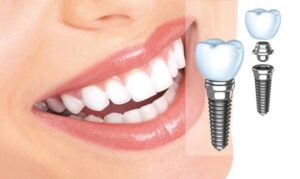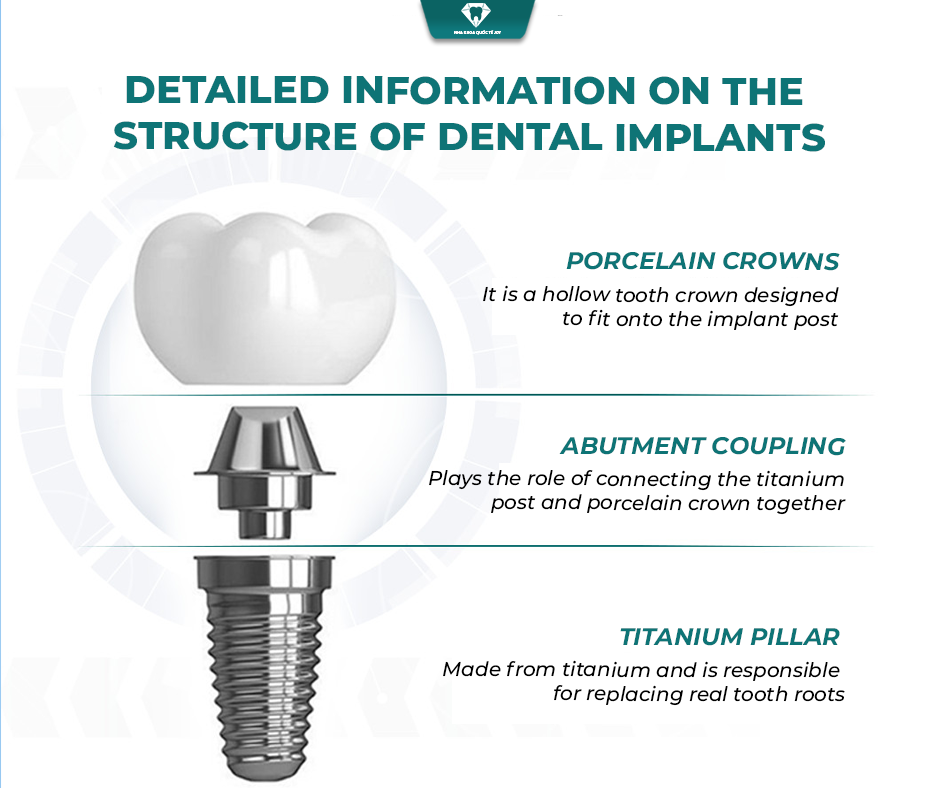Ever wondered what makes dental implants so strong and durable? The answer lies in the structure of dental implants. If you’re curious about this topic, don’t miss the following insights. Joy International Dental Clinic will provide you with the most detailed information about the composition of dental implants.
1. The Structure of Key Implant Components
1.1 The Implant Body:
The implant body is arguably the most crucial part of the entire implant procedure. This component is surgically placed into the jawbone, providing a stable foundation, promoting osseointegration (the process of bone fusing with the implant), and stimulating bone growth.
This part is typically made from pure Titanium, a biocompatible material with high applicability and 100% safety for the body, causing no harm or side effects. The implant body has threads or spiral designs to increase the contact area, interaction, and space for jawbone growth. This textured surface is key to successful osseointegration.
Furthermore, the implant’s surface is roughened using various high-tech techniques to enhance adhesion and shorten the healing process after implant surgery. This surface treatment plays a significant role in the long-term success of the implant.

1.2 The structure of dental implants post includes the Abutment joint:
The abutment can be simply understood as a connector between the implant body below and the porcelain crown above. This component’s primary function is to evenly transmit chewing forces from the crown to the implant body and the jawbone. This even distribution of force is essential for preventing stress concentrations and ensuring the long-term stability of the implant.
The abutment is usually made of Titanium, Zirconia, or other alloys. Abutments also come in various structures and shapes, depending on your oral condition and the implant’s placement location. There are two main types of abutments: stock (pre-manufactured) and custom (patient-specific). Custom abutments often provide a better fit and improved aesthetics, especially in the front teeth.
1.3 The Porcelain Crown:
The final part of a dental implant is the porcelain crown on top. This is the part that resembles a natural tooth, with the primary functions of supporting chewing and restoring your smile’s aesthetics. The crown is meticulously crafted to match the surrounding teeth in size, shape, color, and translucency.
This component is usually made of solid porcelain or can also be made of porcelain fused to metal. High-quality porcelain materials are the preferred choice due to their superior aesthetics and durability. The crown is cemented or screwed onto the abutment, completing the implant restoration.

2. The Significant Role of Implants in Restoring Teeth
2.1 Superior Aesthetics:
The first and most obvious benefit of dental implants is the improvement in aesthetics. They help you regain confidence, improve communication, and enhance your daily life. Implants look, feel, and function like natural teeth, providing a seamless and natural-looking smile.
Furthermore, this method does not affect or invade adjacent teeth, ensuring complete oral health. Unlike traditional bridges that require the grinding down of adjacent teeth, implants stand independently.
In addition, if tooth loss is left untreated for too long, it can lead to bone loss, gradually causing a sunken facial appearance. Implants help prevent this bone loss, preserving facial structure.

2.2 Restoring Chewing Function:
Chewing is an essential function that affects many other health issues. Therefore, implants are a safe, fast, and suitable solution. They allow you to chew comfortably like natural teeth, even hard foods. This improved chewing function leads to better digestion and nutrient absorption.
When you have a full set of teeth, your pronunciation will also be clearer. This minimizes the risk of speech impediments. And of course, when chewing function is good, you will have a healthier and more efficient digestive system.
2.3 Long-Term Durability:
Most implant methods offer long-lasting results. Combined with attractive warranty policies, you can confidently use these teeth for more than 10 years. However, if you combine this with proper and regular oral hygiene, you can confidently use them for 20 to 30 years, or even a lifetime, especially if you choose high-quality European implants.
2.4 Minimizing Bone Loss:
Implants act as natural tooth roots, stimulating jawbone growth and maintaining bone density, preventing bone loss after tooth loss. Preserving the jawbone helps maintain facial structure and avoids deformities caused by bone loss. This is one of the key advantages of implants over other tooth replacement options.
2.5 Preventing Adjacent Tooth Shifting:
Untreated tooth loss creates gaps, causing adjacent teeth to shift and tilt towards the empty space. Implants help maintain the space and prevent teeth from shifting and tilting. Tooth shifting can lead to bite misalignment, causing difficulty in chewing and affecting the temporomandibular joint (TMJ).

3. Important Considerations When Choosing Implants
3.1 Choose Implants with Clear Origin:
You should prioritize implant brands with proven quality and reputation, trusted and recommended by many experts. You can also request the clinic to provide clear information about the origin and source of the implants. Avoid choosing cheap implants of unknown origin, as this can have significant negative impacts on your health.
3.2 Choose the Right Type for Your Bone Condition:
Usually, before implant placement, you will have X-rays or CT scans to assess your bone density and jawbone quality. From there, the doctor will give some advice and choices for you, so that it best suits your budget and oral health. Discuss this issue thoroughly with your doctor before making a decision.
3.3 Choose a Reputable Dental Clinic:
Choosing a reputable dental clinic is also an important factor that determines the success of your implant placement. You should choose rputable and high-quality dental clinics. Do not be tempted by cheap prices to avoid unwanted consequences. Joy International Dental Clinic is always ready to accompany you on your journey to spreading smiles.
Conclusion
Understanding the structure of dental implants is an important part of making the right decision about tooth restoration. Joy International Dental Clinic, with a team of highly specialized and experienced doctors in the field of implants, is always ready to accompany you on your journey to finding a perfect smile. Contact Joy’s hotline for further advice and to schedule your fastest appointment.






